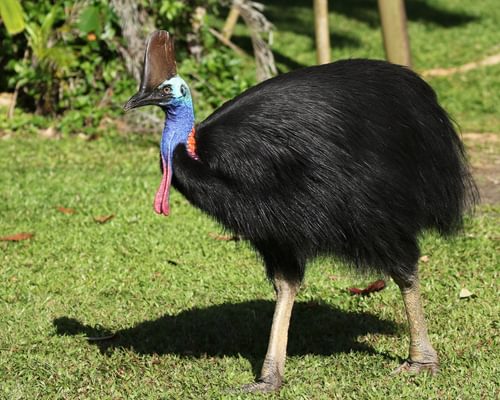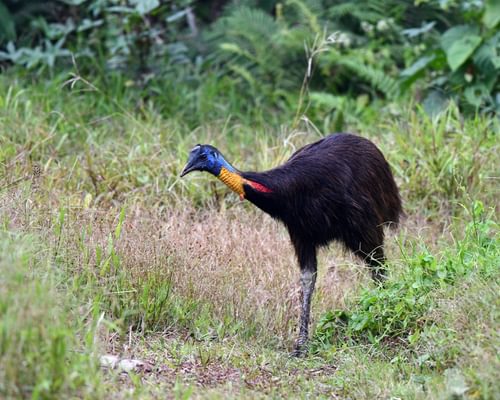Dwarf Cassowary
Near ThreatenedCasuarius bennetti
Visual Identification
Appearance
The Dwarf Cassowary is the smallest of the three cassowary species, yet it is still an imposing bird. It stands about 1-1.5 meters tall, with a predominantly black plumage and a distinctive blue neck and face. The head features a prominent casque (horn-like structure) and vibrant wattles.
Both sexes look similar, with females slightly larger. Juveniles have brown plumage, lacking the bright colours and developed casque of adults. The bird's powerful legs and dagger-like claws are notable features.
Size
Length
99cm to 150cm
Weight
17.5kg to 26kg
Colours
Males and females have similar plumage
Primary Colour
Black Blue
Secondary Colour
Red
Beak Colour
Grey
Leg Colour
Grey
Habitat and Distribution
Habitats
Woodland
Garden
Wetland
Coastal
Urban
Farmland
Grassland
Desert
Tundra
Rainforest
Mountain
Savanna
Distribution
The Dwarf Cassowary is endemic to the island of New Guinea. It inhabits montane and hill forests and is found in both Papua New Guinea and Indonesian Papua. It prefers elevations between 1,000 and 3,600 meters.
These birds are non-migratory and maintain year-round territories within their forest habitats. They are most commonly found in areas with dense understory vegetation and abundant fruit-bearing trees.
Elevation Range
Up to 3,600 meters
Climate zones
Tropical
Distribution Map
This map gives you a rough idea of where you might spot a Dwarf Cassowary. The coloured areas show countries where these birds have been seen.
A few things to keep in mind:
- Birds might not be everywhere in the coloured areas, for example, they may be present around the coast of that country
- Where birds live can change with seasons and available food
- This map is quite simple - it doesn't show exact locations
We're working on making our maps even better! Soon, we hope to show you:
- More detailed maps for bigger countries, including state and region
- How birds move around during different seasons
Distribution by Region
Behaviour and Ecology
Bird Attributes
This feature is in beta. We'd love your feedback to improve it!
Share your thoughtsBird Attributes Explained
Our bird attributes system rates various aspects of a bird's capabilities on a scale of 0-100, based on data from field observations, scientific studies, and expert knowledge.
Attribute Categories:
- Agility: Manoeuvrability, speed, and grace in flight or movement.
- Strength: Physical power, often correlating with size and hunting abilities.
- Adaptability: Ability to thrive in various environments or changing conditions.
- Aggressiveness: Territorial behaviour and assertiveness, particularly during breeding seasons.
- Endurance: Stamina, often seen in migration patterns or foraging behaviours.
Understanding the Ratings:
- 0-20: Very Low
- 21-40: Low
- 41-60: Average
- 61-80: High
- 81-100: Very High
Remember, these attributes are relative to other bird species and don't necessarily indicate superiority.
Hover over the icon next to each attribute for more information.
Tap the icon next to each attribute for more information.
Agility
Reflects the bird's manoeuvrability, speed, and grace in flight or movement.
The Dwarf Cassowary exhibits remarkable agility for its size. It can move quietly through dense undergrowth, run at high speeds, and jump up to 1.5 metres high from a standing position, demonstrating exceptional manoeuvrability in its rainforest habitat.
Strength
Indicates the bird's physical power, often correlating with size and hunting abilities.
With powerful legs and dagger-like claws, the Dwarf Cassowary possesses formidable strength. Its ability to kick and break open tough-skinned fruits and defend itself against potential threats indicates significant physical power for a bird of its size.
Adaptability
Represents the bird's ability to thrive in various environments or changing conditions.
While specialised for its montane rainforest habitat, the Dwarf Cassowary shows some adaptability. It can thrive in elevations from 1,000 to 3,600 metres and maintains a varied diet of fruits, small vertebrates, and invertebrates. However, its specific habitat requirements may limit broader adaptability.
Aggressiveness
Measures the bird's territorial behaviour and assertiveness, particularly during breeding seasons.
Though generally shy, Dwarf Cassowaries can be highly aggressive when threatened. Their powerful legs and claws serve as formidable weapons, and their reputation for potential aggression towards humans suggests a strong defensive nature when provoked.
Endurance
Reflects the bird's stamina, often seen in migration patterns or foraging behaviours.
As a non-migratory species adapted to moving through dense forest, the Dwarf Cassowary likely possesses good endurance for sustained activity in its habitat. However, as a primarily terrestrial bird not known for long-distance movements, its overall endurance may be moderate compared to migratory species.
Diet
Dwarf Cassowaries are primarily frugivorous, feeding on fallen fruits from rainforest trees. They play a crucial role in seed dispersal. Their diet also includes small vertebrates, invertebrates, and fungi. They use their strong feet to kick and break open tough-skinned fruits.
Behaviour
Dwarf Cassowaries are solitary and elusive, moving quietly through dense rainforest undergrowth. They are primarily terrestrial, capable of running at high speeds and jumping considerable heights when necessary.
These birds are generally shy but can be aggressive if threatened, using their powerful legs and claws for defence.
Vocalisation
Dwarf Cassowaries produce deep, booming calls that can travel long distances through the forest. These low-frequency vocalisations, often described as a rumbling 'boom-boom-boom', are used for communication and territorial displays. They may also emit hisses or grunts when alarmed.
Nesting & Breeding
Breeding occurs year-round, with a peak during the drier months. Males are responsible for nest building and constructing a simple ground nest of leaves and plant material.
Females typically lay 3-5 eggs, which are bright green. The eggs are large, weighing up to 650 grams each.
Male cassowaries take on all incubation and chick-rearing duties. The incubation period lasts about 50 days, with chicks remaining with the male for up to 9 months after hatching.
Lifespan
years
The Dwarf Cassowary typically lives for 20 to 40 years.
Like all birds, lifespan can be affected by factors including predation, habitat quality, disease, and access to food sources.
Conservation and Status
Global Conservation Status
Due to habitat loss and hunting pressures, the dwarf cassowary is classified as near threatened. Conservation efforts focus on protecting rainforest habitats and regulating hunting practices. Climate change poses an additional threat, potentially affecting mountain forest ecosystems.
Population Data
Global Population Estimate
Unknown
Birdwatching Tips
- Look for them in the dense, mountainous rainforests of New Guinea
- Listen for low-frequency booming calls, especially during breeding season
- Search for distinctive three-toed footprints on forest floors
- Be cautious and maintain a safe distance if encountered
Additional Information
Quick Facts
Other names:
Bennett's Cassowary, Mountain Cassowary
Family:
CasuariidaePredators
Adult Dwarf Cassowaries have few natural predators due to their size and defensive capabilities. However, eggs and chicks may fall prey to large pythons, monitor lizards, and feral pigs.
Did You Know?
- The Dwarf Cassowary's casque is made of spongy material and may help amplify their vocalisations.
- They can jump up to 1.5 meters high from a standing position.
- Cassowaries are considered living dinosaurs, with feet resembling those of theropod dinosaurs.
Was this bird profile helpful?
Your feedback helps us improve our content
Thanks for your feedback!
Your input helps us improve our content.
Community Experience
Community Ratings
No ratings yet - be the first to rate this bird!
Latest Community Reviews
No reviews yet
Sign in to be the first to review
Community Reviews
Create Your Free Account Welcome Back!
Join our community to rate birds and share your experiences. Creating an account is completely free and only takes a minute. Sign in to your account to rate birds and share your experiences with our community.
Your information is secure and will never be shared.
By creating an account, you agree to our Privacy Policy.
Similar Birds
References
- 1
website: BirdLife International. 2016. Casuarius bennetti. The IUCN Red List of Threatened Species 2016: e.T22678111A92755192.
View source - 2
report, 2012: B. Beehler in litt.

